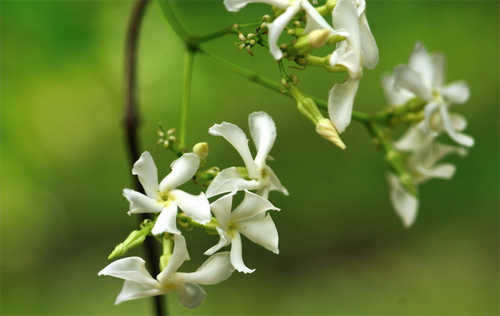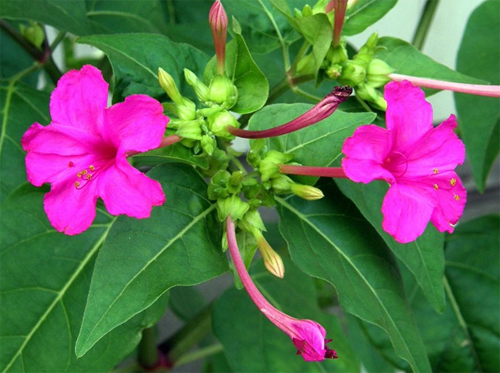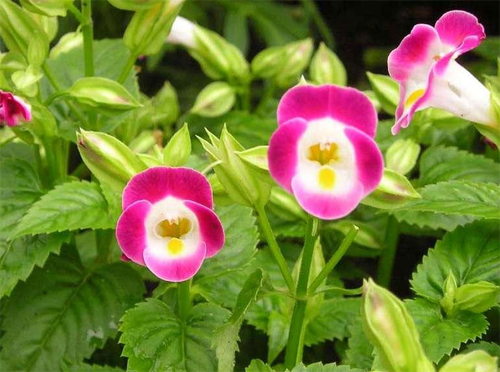How to reproduce in the culture method of Luoshi vine
Luoshi vine is what we call windmill flowers. We have seen it before. Luoshi rattan grows to have feet, likes to climb everywhere, and can crawl houses and trees. What is the breeding method of Luoshiteng? How does Luoshiteng propagate?

The culture method of Caulis angustifolia
1. Soil and light
Its adaptability is very strong, the drainage of the soil is a little better, like sufficient light, pot cultivation in a cool place is also okay, only slightly affect flowering.
2. Temperature
Luoshi vine is a relatively hardy plant, which can survive the winter in the open field in South China, while the flower friends in North and Northeast China can only carry out pot conservation. It can grow healthily at minus 20 degrees, which shows that its cold resistance is still good.
How does Luoshiteng reproduce:
Generally, striping propagation is carried out, and the survival rate is basically 100%. The cuttage is also easy to survive, and its strong rhizome is simply thrown into the soil to grow.
Striping propagation is the simplest, a section of stem nodes in contact with the soil after cutting off ramet, this method can reproduce many plants at a time.
Variants of Luoshi:
Huaye Luoshi is a variety of Luoshi, more common in the south, the new leaf is pink mixed with white and green, looks very beautiful, is a great ornamental variety.
It is also a good potted variety, or listen to your popularity, its new leaves look like flowering plants from a distance, it is very charming.
Its leaves will change according to the intensity of light, but not too much, proper light is the best.
Luoshi vine breeding methods and breeding methods are introduced here, do not hurry to their own home to raise one.
An inventory of the culture methods and techniques of Luoshi vine
Vines are generally used for shading, or as natural screens, but that's what vines do. But in traditional Chinese medicine, there is a kind of vine that is used as medicine. This kind of vine is Luoshi rattan. Luoshiteng is often used to treat rheumatic paralysis and cool blood to reduce swelling. For most people who fall and sprain, traditional Chinese medicine practitioners will prescribe Luoshiteng as a way to cool the blood and reduce swelling to promote faster wound recovery. Luoshi vine is generally rattan-like growth, the surface is reddish brown, the texture is relatively hard, not easy to break. Therefore, today I would like to introduce to you the breeding methods of Luoshi vine and the related introduction of Luoshi vine.
Luoshiteng, alias stone dace, bright stone, hanging stone, Yunzhu, Yundan, red pair leaf kidney, white flower vine, Latin name (Trachelospermumjasminoides.) The stem of a leafy vine that is a plant of the family Apocynaceae. The nature is slightly cold and the taste is bitter. Dispelling wind and dredging collaterals, cooling blood and reducing swelling. For rheumatic heat arthralgia, muscle and pulse contracture, waist and knee pain, throat arthralgia, carbuncle swelling, fall injury. Distributed in Henan, Shandong, Anhui, Jiangsu, Zhejiang, Fujian and other places.
The culture method of Caulis angustifolia
Luoshiteng Xiyin, still resistant to cold, can spend the winter in the open field, do not have high requirements for soil and fertilizer, and any fertilizer can be applied.
General soil can cultivate Luoshi rattan, Luoshi rattan blossoms in April, can blossom for about half a month, grow very fast, can grow 1.5 meters a year.
Generally, Luoshi rattan is planted in the north of the house, and the seeded and propagated Luoshi rattan generally does not blossom. Light soil is required for planting Luoshi rattan in the pot, and manure water is properly applied once, but the seedlings that have just survived cannot be fertilized.
Change the basin every 4 years or so, the most appropriate time to change the basin in March, Frosts Descent moved into the room before.
Move out before Qingming Festival the following year, and pay attention to watering before moving out.
When there is heavy rain in summer, the flowerpot should be placed upside down to avoid stagnant water in the pot so as not to rot the roots.
Luoshi vine generally does not prune during the growing period, transplanting and changing pots must bring soil balls.
The stems and branches of Luoshi rattan are slender and can be shaped in various shapes.
Methods of reproduction:
Luoshi vine can be propagated mainly by pressing strips, and it can also be cut and sown and propagated. Every year spring and autumn can be pressed into strips, and the time is about March. In July, it is possible to press strips with twigs, basin pressure or open ground pressure. When basin pressure, a branch can be continuously pressed into several basins, and the depth of pressing strips into the soil is generally about 3 cm. At least 3 buds should be pressed, and one bud in the middle is pressed in the soil.
The other two buds are exposed outside the soil and keep in contact with the surface of the basin soil, so that they can take root fastest and can take root at internodes and nodes, but there are not as many roots at nodes as they do in spring. The old branches of Ruoshi vine in spring take root more slowly, and they can not be separated from the mother plant until about August. If they are moved indoors in winter, if they are pressed in the open field, they should be covered with grass curtains to prevent freezing, and the branches pressed into the soil should generally be stripped of green leaves. Luoshi vine pressed without watering, old branches are often thick leaves and flowers, while young branches are often sparse leaves and few flowers.
After patiently introducing to you today the nourishment of Luoshiteng, falling iron and other drugs to be used together. People who are afraid of cold and easy to release must not be used, otherwise it will easily lead to physical damage.
Is Luoshiteng a Parthenocissus? Is Luoshiteng poisonous? How to raise Luoshiteng?
Luoshi vine, also known as hanging stone, bright stone, etc., like Parthenocissus, both belong to woody vines and are good materials for hedgerows, so it is often thought that Luoshiteng is Parthenocissus. At the same time, because Ipomoea angustifolia is a plant of Apocynaceae, as we know, Apocynaceae plants usually contain a certain degree of toxicity. So, is Luoshiteng a Parthenocissus? Is Luoshiteng poisonous? How to raise Luoshiteng? The following editor will answer for you one by one.
Picture: Luoshiteng
Is Luoshiteng a creeper?
Luoshiteng is not Parthenocissus. Liriodendron is a plant of the genus oleander, while Parthenocissus is a plant of the grape family, so they are two different plants. The biggest difference between Luoshiteng and Parthenocissus is that its leaves are ovate-lanceolate or oval, while those of Parthenocissus are often 3-lobed, coarsely serrated and turn bright red in autumn.
Picture: Parthenocissus
Is Luoshiteng poisonous?
Luoshiteng is poisonous. The juice of Liriodendron is poisonous, that is, the milk that comes out when the branches are broken. Eating by mistake can hurt the heart and cause poisoning, so don't try randomly. In addition, Luoshiteng has no other toxicity, so as long as people do not eat Luoshiteng, there is no need to worry about poisoning.
Third, how to raise Luoshiteng?
1. Planting management: Luoshi vine likes shade, is still resistant to cold, can spend winter in open field, does not have high requirements for soil and fertilizer, and any fertilizer can be applied. In general, it can be cultured in soil. Luoshi vine blossoms in April, can blossom for about half a month, and grows very fast. It can grow 1.5 meters a year. Generally speaking, Luoshi vine is planted in the north of the house, and the sowing and propagation of Luoshi vine generally does not blossom. Properly apply manure and water once, but the seedlings that have just survived cannot be fertilized. The pots can be changed every 4 years or so, and the most suitable time to change pots is about March. Frosts Descent moved indoors before the Qingming Festival and outside before the Qingming Festival in the second year. Pay attention to watering before moving out. When there is heavy rain in summer, the flowerpot should be placed upside down to avoid stagnant water in the pot, so as not to rot the roots. Luoshi vine generally does not prune and prune during the growing period, transplanting and changing pots must bring soil balls. The stems and branches of Luoshi rattan are slender and can be shaped in various shapes.
Picture: Luoshiteng
two。 Propagation method: Luoshi vine can be propagated mainly by striping, and can also be cut and sown. It can be crushed every spring and autumn, about March, with old branches, and in July with twigs, basin pressure or open ground pressure. When basin pressure, a branch can be continuously pressed into several pots, the depth of the strip is generally about 3 cm, at least 3 buds should be pressed into the soil, and the middle bud should be pressed in the soil. The other two buds are exposed outside the soil and keep in contact with the surface of the basin soil, so that they can take root fastest and can take root at internodes and nodes, but there are not as many roots at nodes as they do in spring. The old branches of Ruoshi vine in spring take root more slowly, and they can not be separated from the mother plant until about August. If they are moved indoors in winter, if they are pressed in the open field, they should be covered with grass curtains to prevent freezing, and the branches pressed into the soil should generally be stripped of green leaves. Luoshi vine pressed without watering, old branches are often thick leaves and flowers, while young branches are often sparse leaves and few flowers.
[editor's conclusion] Luoshiteng is not a creeper, and the juice is toxic, so we should not eat it. The above is the content sorted out for you by the editor of the first Agricultural Economic Network, hoping to help you!
- Prev

How does purple jasmine grow seeds? what's the price?
Purple jasmine is a very common plant, which can be seen in many places. there is only one plant this year and will become a piece next year. It can be seen that the reproductive ability of purple jasmine is not generally strong, how to plant purple jasmine, what is the seed price of purple jasmine: how to grow purple jasmine: soil selection.
- Next

What is the breeding method and breeding price of Corydalis?
Corydalis is a kind of plant, and its flowers are similar to those of trumpet flowers, but unlike trumpet flowers, Corydalis can't get up and walk. What are the breeding and breeding methods of Corydalis? How much is the price of Corydalis? The breeding method of Corydalis: appropriate light, above also to Corydalis not afraid of the sun
Related
- Fuxing push coffee new agricultural production and marketing class: lack of small-scale processing plants
- Jujube rice field leisure farm deep ploughing Yilan for five years to create a space for organic food and play
- Nongyu Farm-A trial of organic papaya for brave women with advanced technology
- Four points for attention in the prevention and control of diseases and insect pests of edible fungi
- How to add nutrient solution to Edible Fungi
- Is there any good way to control edible fungus mites?
- Open Inoculation Technology of Edible Fungi
- Is there any clever way to use fertilizer for edible fungus in winter?
- What agents are used to kill the pathogens of edible fungi in the mushroom shed?
- Rapid drying of Edible Fungi

